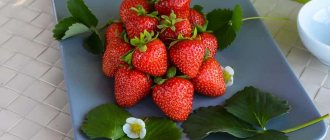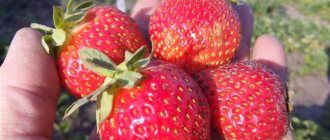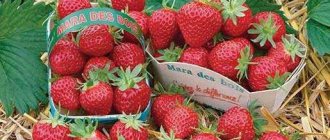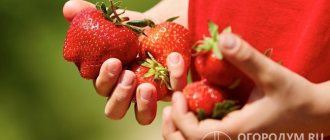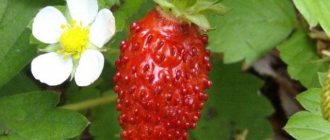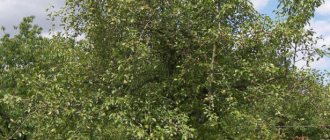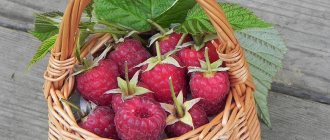Home / Garden / Berries
Back
Published: 06/22/2020
0
Rate this post
It’s rare to find garden strawberries, especially large-fruited ones, with diametrically opposed reviews about their taste. And Vikoda strawberries are just one of those varieties about which gardeners have never come to a consensus. Some talk about the sheer merits of the Dutch berry, while others, having harvested their first harvest, plan to uproot the bushes to replace them with others.
Why didn’t Vikoda strawberries please Russian summer residents? Maybe the reason is that the variety was not originally the goal of the breeders, but turned out by accident? But it’s not in vain that Vikoda’s strawberries were included in the Belarusian register, although according to experts, almost a point falls short of the highest rating of taste. Or is it that the characteristics of the berry crop did not live up to expectations due to weather and care? In search of answers, we study the description of the variety.
- 1 Varietal features 1.1 Plant
- 1.2 Berry
Description of the strawberry variety Vikoda
The non-repairing variety has medium-sized bushes that grow in width over time. Vikoda grows a lot of foliage, and the leaf blade is large, dark green, not very wrinkled, with wide and blunt teeth. Strawberries produce little mustache. Vegetative shoots are pale red. Bushes of the first year of growth produce up to 7 peduncles with buds below the level of the top of the foliage. Vikoda brushes have many flowers with large distances between them. Each strawberry flower is white, untwisted, and requires pollination.
Vikoda berries are large and very large. The average weight of one strawberry is 60 g, but many specimens weigh up to 120 g. Throughout the entire harvest season, there is no great variation between the berries. The shape of strawberries of this variety is irregular, sometimes very bizarre with ribs and ridges, sometimes barrel-shaped, sometimes flattened.
According to Vikoda's description of strawberries, as they ripen, they acquire a rich red color. The top of the berries often remains whitish or green. Ripe strawberries usually shine in the sun. Its calyx is easily separated. The yellowish seeds are sunk into the pulp, which has a delicate structure and a delicate sweet taste. According to reviews, Vikoda strawberries have a slight fruity aftertaste, reminiscent of cherries. Tasters give a rating of 4 points out of a possible 5. The sugar content reaches 9.2%.
Characteristics of the variety
Late ripening, large fruit and winter hardiness are the key features of Vikoda strawberries. Gardeners and agricultural firms in central Russia chose this variety because it has many valuable advantages.
Main advantages
With demands on soil fertility, which is characteristic of all large-fruited strawberry varieties, Vikoda needs 2-3 mineral or organic fertilizers during the growing season. It needs watering for fruiting. To prevent moisture loss, it is recommended to mulch the ground under the bushes. Pruning and covering the planting with straw are the main measures for preparing the beds of this variety for wintering.
Flowering period, ripening time, yield
The Vikoda variety is a late variety. Flowering starts in July and only by the end of the month should we expect the first ripe berries. These are the timing for planting strawberries in open ground. When grown in greenhouses, the timing can be shifted by 2-3 weeks, bringing the ripening of the crop closer.
The Vikoda variety is sensitive to watering and light. In sunny summers, with sufficient watering or rain, each bush can produce 0.9-1.3 kg of berries. Gardeners note that the maximum yield of the variety is observed in years 2 and 3, after which the strawberry planting should be renewed.
Application area
Vikoda strawberries are mainly used for fresh consumption and for preservation. It makes delicious jams, juices, preserves. The variety is suitable for freezing, since after thawing the berries remain firm and do not lose their pleasant aroma and taste.
Resistance to diseases and pests
The Dutch variety is resistant to gray rot, and leaf spot is an extremely rare occurrence. At the same time, the threat of powdery mildew and root diseases (especially verticillium wilt) remains, therefore, in early spring and after harvest, preventive treatments of strawberries with fungicides are carried out and the recommended planting density is strictly observed.
Advantages and disadvantages of the variety
The late ripening period of Vikoda strawberries is considered its main advantage. The size of the berries and their pleasant cherry taste and aroma are what lovers value it for. The variety is winter-hardy in central Russia and is rarely affected by return frosts, since flowering does not occur until spring is over.
The disadvantage, according to reviews of the Vikoda strawberry variety, is the deterioration of its taste due to lack of watering and extreme heat. Watering should therefore occur at least 2 times a week until the fruiting season ends.
A small number of vegetative shoots is both a plus and a minus, since you don’t need to cut off the excess, but you won’t be able to get too much planting material from the bush. When it is necessary to obtain daughter rosettes, the flower stalks are removed from the bush. Dividing the bushes and shortening the roots of the seedlings also helps.
Reproduction methods
Like other varieties of garden strawberries, Vikoda propagates by means of tendrils. Vegetative shoots are formed in small quantities, but at the ends they have well-formed rosettes with aerial roots. It is enough to choose a good place for their rooting in order to get the first berries from them next year.
Dividing the bush is an extreme measure of propagation, since the plant will have to spend a lot of time and effort on rooting. It will be possible to get a harvest from these bushes only in a year. This is done only when there are no mustaches on the uterine bushes.
According to reviews from gardeners, Vikoda strawberries, or rather its seedlings, are easy to obtain from seeds. Sowing is carried out in the first ten days of March. Shoots usually appear after 10 days. Seedlings can be picked from a common box at the stage of the 2nd true leaf. Place boxes and cups with seedlings in the sunniest place and make sure that the air temperature does not fall below + 20 °C. Planting in open ground is most often carried out when the first flowers appear. Usually, this happens in the first ten days of June.
Reviews
Irina, Novosibirsk
The variety is irreplaceable for our region. Does well in cold climates. It bears fruit for a very long time, I collect the harvest from the plot in buckets. Even when frozen it does not lose its taste.
Valentina, Gorokhovets
I have been growing the Vikoda variety for three years now. The taste of fresh berries is not for everyone. I like sweeter strawberries, but this one is sour. On the other hand, we eat fresh berries all summer, since I plant different varieties. The compotes made from these strawberries are very tasty.
Landing rules
When the planting material is seedlings, sunny days in the first ten days of summer are chosen to place them in the beds. In greenhouses you can plant a month earlier. In some cases, preference is given to greenhouses, then the second half of May is suitable.
Choose a sunny place; shading is allowed only in the afternoon. Without the sun, the berries will not be able to gain sweetness. The soil must be fertile. It is ideal to add humus or rotted manure to it in the fall. When it comes to the best predecessors, preference is given to cruciferous vegetables and legumes.
You can plant replacement beds in the second half of summer, using mustaches for this. August is optimal for this. The landing pattern is as follows:
- in row spacing – 40 cm;
- between bushes - 60 cm.
It is important to ensure that the growth point at the root collar is not covered with soil. Immediately after sprinkling the roots with soil, the young bush should be watered well. Mulching is performed on the same day.
The Vikoda strawberry variety is excellent for vertical plantings. They are used when there is not enough space on the site for full-fledged beds. The main thing is to provide enough space for the roots. The recommended depth of planting containers is 35-40 cm.
Reproduction
The Vima Zanta variety is very easy to propagate with the help of numerous tendrils. Whiskers or, in other words, daughter rosettes are formed throughout the growing season. On average, one well-developed mother bush can produce up to 15-20 young plants. Most of the mustaches are formed by 2-3 year old bushes. As we age, conformation gradually decreases.
The advantages of reproduction with a mustache include:
- Full preservation of varietal characteristics.
- Almost 100% survival rate.
- Ease of reproduction.
To obtain the maximum number of runners, all peduncles are removed from the selected plants. This allows you to get the maximum number of daughter sockets. July whiskers are best suited for propagation. They manage to take root well before the onset of frost and therefore overwinter with virtually no losses.
For reproduction, it is best to use first-order whiskers. If necessary, the others can be used, but they are usually much smaller and weaker. For faster rooting, selected shoots are pinned to the ground and lightly hilled. As soon as the mustache takes root and begins to grow, they begin to be planted.
The rooted mustache is dug up using a scoop or small spatula. The dug plant is transferred to a pre-prepared planting bed.
When planting young bushes, it is necessary to monitor the depth level of the growing point. It should be slightly above ground level. Excessive deepening or elevation of the heart will lead to the death of the bush.
After planting is completed, the bed is watered abundantly, and the soil surface is mulched with a layer of straw, peat or humus. To create greenhouse conditions, seedlings are covered with a layer of non-woven material. It effectively protects from the sun while maintaining a constant level of humidity.
Subsequent care of the crop
Based on the descriptions of the Vikoda strawberry variety and photos, we can conclude that it is very moisture-loving and has a negative attitude towards drought and heat. In the southern regions, it will not be possible to get a harvest without watering. The second mandatory rule is to loosen the soil under the bushes the next day after moistening the soil. To make maintenance easier and not loosen the soil too often, you should mulch it with sawdust, straw, and dry grass.
Fertilizing will be required twice - before budding (ammophoska or wood ash), and then when the berries are forming (a glass of manure per 10 liters of water). Complex mineral fertilizer is applied during watering. The culture reacts well to solutions of bird droppings.
Preparing for winter
Before the first autumn frosts, the bushes must be prepared for winter. To do this, trim the ground part without affecting the growth point. Be sure to apply fertilizer: you can scatter dry rotted manure under the bushes or fertilize with mineral fertilizer or a solution of wood ash. At the same time, water the beds abundantly, adding at least 10 liters of water under each bush to nourish the strawberries and strengthen them before the upcoming winter. It is recommended to cover the Vikoda with straw. In frosty, snowless winters, this measure will prevent strawberries from dying.
Strawberries in autumn
After pruning, strawberry beds are treated with insecticides and fungicides for preventive purposes. Plants growing new leaf mass need watering, weeding and loosening, and strawberry roots need to be fertilized with mineral and organic fertilizers.
Before the onset of cold weather in areas with a cool climate, strawberry beds are covered with a continuous layer of straw manure or fallen leaves 5-7 cm thick to protect the leaves and roots of the plants from freezing in the event of a snowless and frosty winter.
In the southern regions, they take this method of protecting strawberries: in the spring, from east to west, sorghum curtains are sown every 4-5 rows of strawberries. Thus, in the summer the strawberries are shaded by curtains from the hot sun, and in the winter they contribute to snow retention, which allows not only to protect the strawberries from frost, but also to accumulate moisture in the ground.
Disease and pest control measures
If traces of disease damage to strawberry leaves and fruits are found, they should be collected and burned immediately. Preventive treatment with specialized preparations against powdery mildew is the main protective measure, but it may not be necessary if the planting is not thickened.
The main threat to ripening strawberries is slugs and snails. They can be collected manually in the morning, but large areas will have to be treated with drugs. This is done before the ovaries form. A popular folk remedy is to sprinkle wood ash on the ground under strawberry bushes. It repels slugs and snails.



